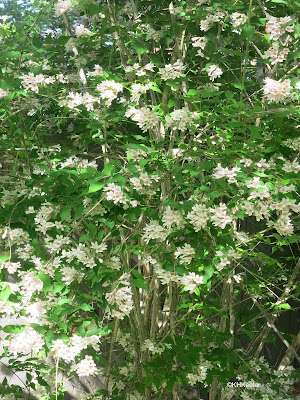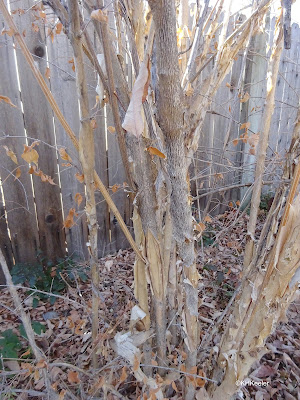Beauty bush is a pretty shrub native to central China. It is a member of the honeysuckle family, Caprifoliacae. It was introduced first to Great Britain about 1900 and then to the United States. It became a popular garden plant in the U.S., though it was never as popular in Europe or China. It is rare in the wild. In the United States, it has naturalized in at least seven states, from Massachusetts to Utah.
 |
| Beauty bush, Linnaea amabilis or Kolkwitzia amabilis |
It is a pretty shrub, growing to about 10' high with an arching shape. In spring, it can be covered in pinkish white flowers with yellow centers.
 |
 |
| Close up of beauty bush flowers, featuring a bumblebee's butt (right, middle) |
Beauty bush's scientific name honors German botanist Richard Kolkwitz as Kolkwitzia, with the species epithet amabilis, meaning lovely. When it was named, in 1901, beauty bush was the only plant in the genus Kolkwitzia. More than 100 years later, it remains the only Kolkwitzia. In 2013, Christenhusz at Kew Gardens published an analysis that moved beauty bush into the genus Linnaea. There is a clear lineage of honeysuckle relatives from a single source (monophyletic) that includes Kolkwitzia and Linnaea, and others. By putting them all into the genus Linnaea, Christenhusz drew a bigger circle, making a genus containing 16 species. Before that, Kolkwitzia, Linnaea, Vesalea, and Diabelia were single-species (monotypic) genera, Dipelta had three species, and the other nine species were Abelia species. World Flora Online and Wikipedia have accepted this revision but you find beauty bush as Kolkwitzia in the U.S.D.A. Plants data base, Missouri Botanic Garden's plant list and Kew Gardens' International Plant List Index. It has been a decade since the publication, which suggests that some authorities don't agree about the merger. Going with the change, all the nurseries will have to learn a new name; but at the same time, for everyone, there will be five fewer genus names to learn.
 |
| beauty bush, Linnaea amabilis |
 |
| beauty bush |
I have generally preferred lumping to splitting, putting more species into a genus, not making more genera. I have now learned Kol-k-witz-i-a is the genus for beauty bush, but I learned the genus Linnaea long ago. It will be easy remember that Linnaea is beauty bush's scientific name, so I'll support the revision. Not everyone likes the revision, you can join either group.
 |
| Plant in full flower |
Comments and corrections welcome.
References
Christenhusz, M. J. M, 2015. Twins are not alone: a recircumscription of Linnaea (Caprifoliaceae). Phytotaxa. 125 (1) 25-32.
- The International Plant Names Index and World Checklist of Vascular Plants 2023. Kolkwitzia amabilis. Published on the Internet at http://www.ipni.org and https://powo.science.kew.org/ link
- Kolkwitzia amabilis. Missouri Plant Finder. link Accessed 12/21/23.
- Lauener, L.A. 1996. The Introduction of Chinese Plants to Europe. SPB Academic Publishing, Amsterdam, the Netherlands.
- Linnaea amabilis. North Carolina Extension Gardener Plant Toolbox. link Accessed 12/21/23.
- Linnaea amabilis. 2023. Wikipedia. link Accessed 12/23/23.
- WFO. 2023. World Flora Online. Published on the Internet. Kolkwitzia amabilis link Accessed 12/23/23.
- USDA. 2014. Kolkwitzia amabilis. USDA Plants data base. link Accessed 12/23/23.
- Valder, P. 1999. The Garden Plants of China. Timber Press, Portland, Oregon.
- Kathy Keeler, A Wandering BotanistMore at awanderingbotanist.comJoin me on Facebook: https://www.facebook.com/AWanderingBotanist



Very interesting! Beautiful plant. I had never heard of Mrs. Beauty but I am glad to meet her. Thank you for sharing your knowledge.
ReplyDelete